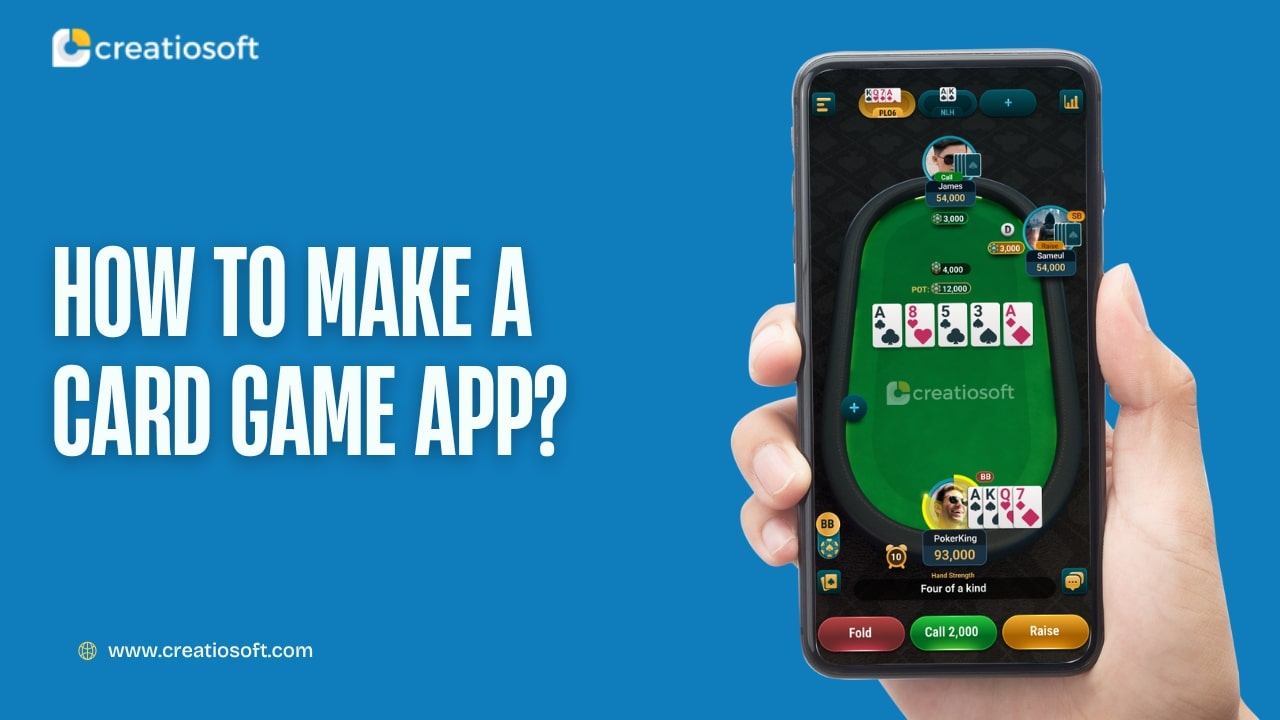The rise of technology has made a major impact on the online card game industry. Post-COVID-19, there has been a massive boost in player activity, with more people turning to digital entertainment, and card games becoming a popular choice. This growing popularity has opened the door for new apps to enter the online iGaming industry, each offering fresh features and unique gameplay experiences to capture the attention of users.
With millions of users around the world playing games like Poker, Rummy, and Solitaire daily. According to Statista, the total revenue in this market is expected to grow at a CAGR of 7.57% from 2022 to 2029, reaching approximately US$21.47 billion by 2029. That number alone provides a viable opportunity for those contemplating entering the market.
If you’re planning to make a card game app, that’s a great choice. But building a successful one takes more than just planning. You need the right game idea, a seamless game app, and a smooth user experience. Whether you’re planning a basic classic or a multiplayer game with real money mechanics, this step-by-step guide will help you understand what it takes to create a card game app that players love.
8 Steps to Develop a Card Game App
1. Do Market Research
Before you begin building anything, take time to understand the market. This crucial step helps you understand the competitive market and identify opportunities for your game.
Start by analyzing existing card games in app stores:
- Study top-performing apps in the chosen category
- Examine user reviews to understand what players like and dislike
- Identify gaps in the market that your app could fill
- Research monetization strategies used by successful competitors
Once you know what players want, you can build a card game app that truly stands out.
2. Define Your Card Game Idea
Creating a successful card game app requires a crystal-clear vision of what you want to build. This phase involves several critical decisions that will shape your entire project.
- Target Audience: Are you creating the app for adults, older adults, or a specific region? This analysis will influence everything from design to features.
- Gameplay Mechanics: Will it be turn-based or real-time? How will scoring work? What happens when someone wins or leaves a game?
- Type of Card Games: Are you building a Poker, Rummy, Solitaire, or something custom? Some games work better in certain markets. Initially, you can go with one of them, and later you can add more card games to your app.
- Features: Think beyond gameplay. The more unique features mean more players will be drawn to your app. Some of the features you should include are voice or video chat options, leaderboards, tournaments, daily rewards, game variants, a seamless withdrawal process, and 24/7 customer support.
When you create a card game app, every small thing matters. A well-thought-out game will attract more players and keep them engaged longer.
3. Build an In-House Team or Work with an Outsourcing Partner
You now have two choices: either hire developers, designers, and testers in-house, or work with a reputed card game app development company. Each option has its pros and cons, so choose wisely before going ahead with either of these options..
If you have a budget and time, an in-house team gives you full control. But if you’re looking to move faster or save costs, outsourcing to experts will be a smart choice. A best card game app development company already knows the technical and regulatory requirements of such apps.
4. Design the User Interface (UI) and User Experience (UX)
A good card game is not just about enjoyment; it’s about how the game feels. Design plays a big role; if your app UI is not attractive, your players will lose interest.
The UI should be clean, responsive, and visually appealing. Use vibrant colors for casual games and darker themes for serious ones. UX is all about flow—how easy is it for users to start a game, the registration process, social features, or explore their wallet?
Animations, sound effects, card flip motions, and subtle transitions all add enjoyment to your app.
UI Design Principles:
- Clear card visibility and readability
- Consistent visual style and branding
- Intuitive navigation and menu systems
- Responsive design for different screen sizes
- Accessibility features for diverse users
UX Considerations:
- Smooth card animations and transitions
- Logical flow between game screens
- Quick access to important functions
- Minimal loading times and interruptions
- Clear feedback for player actions
Must Read: How Much Does it Cost to Develop a Card Game App?
5. Choose the Right Tech Stack
Tech Stack is the backbone of your app. You need to select a tech stack that can handle real-time gameplay, in-app purchases, a user database, and security. Choose the tech stack wisely, because once you start getting thousands of users, you’ll need to scale your platform as your player base grows.
Some popular technologies are:
- Frontend: Unity, Cocos, Flutter, React Native
- Backend: Node.js, Python, or PHP
- Database: MongoDB, MySQL, Firebase
- Server Hosting: AWS, Google Cloud, Azure
- Real-Time interaction: Socket IO
If you’re unsure, the best card game app developers can guide you through this step. They know what works best for your specific game type.
6. Develop the Card Game App
Now it’s time to build. The development phase involves both the frontend (what users see) and the backend (game logic, servers, data).
Start with basic features, also known as the Minimum Viable Product (MVP). This includes registration, gameplay, and wallet systems. Once these are stable, you can add other features like tournaments, chat, and rewards.
Break the development into sprints, test frequently, and ensure every feature works as expected. A lot of game apps fail because of bugs or poor performance, especially during peak traffic.
7. Test Your Card Game App
Once app development is done, test the app thoroughly. Use real devices, simulate bad networks, and test every feature.
Focus on three types of testing:
- Functional Testing: Does the app work correctly?
- Performance Testing: Can it handle thousands of users?
- Security Testing: Are user accounts and transactions safe?
Ask your testers to try breaking the app. The more flaws you catch now, the better your app will perform after launch.
Additional Read: Types of Game Testing Techniques You Need To Know
8. Publish the App on App Stores
After testing, it’s time to launch. Prepare your app store listing carefully. Use clear descriptions, screenshots, and engaging icons.
Submit the app to Google Play and the Apple App Store. Make sure your game follows their guidelines, especially around in-app purchases and age restrictions.
Also, consider releasing in one region first (called a soft launch) to gather feedback and fix any last-minute issues.
Be active on app stores so you can see what issues players are facing and fix them accordingly.
Bonus Tip
9. Do Marketing for Your Card Game App
After publishing the app on the Google Play/App Store, your work is not finished. You need players to know about your new card game app. Start marketing your game as early as possible, before launch. Use social media, game forums, paid ads, influencer partnerships, and app store optimisation to create awareness.
A smart marketing strategy ensures your card game gets noticed, downloaded, and played. The more players your app has, the greater its earning potential.
Also Read: How to Promote Your Card Game App?
Final Words
A successful card game needs clear planning, the right team or development partner, intuitive UI design, and reliable technology. But what truly sets a card game apart is how well it connects with its players.
If you want your app to stand out in the market, focus on delivering smooth gameplay, engaging features, and the best user experience. The goal should be to create a card game app that people love to play and come back to.









